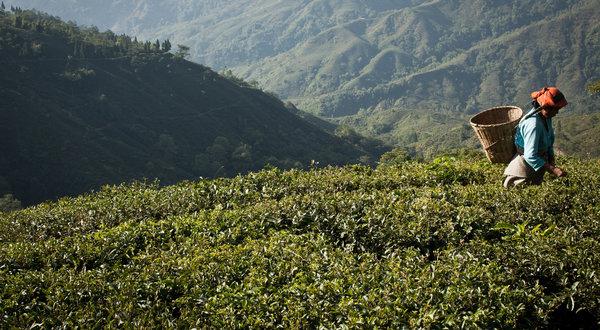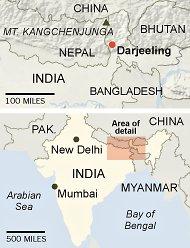December 17, 2012
DARJEELING, India — Among connoisseurs, few teas surpass a good Darjeeling. The smooth and mellow taste commands a premium price, and the name itself evokes a bygone era when the British first introduced Chinese tea plants here in the Indian foothills of the Himalayas.

December 17, 2012
DARJEELING, India — Among connoisseurs, few teas surpass a good Darjeeling. The smooth and mellow taste commands a premium price, and the name itself evokes a bygone era when the British first introduced Chinese tea plants here in the Indian foothills of the Himalayas.

A woman on the Sungma Tea Estate in Darjeeling, India, where growers have followed the example of Scottish whisky distillers and French wineries in limiting the use of certain geographic names to products from those places.
To Anil K. Jha, the superintendent of the Sungma Tea Estate, all this would be extremely good for business, except that much of the tea sold globally as Darjeeling is not actually grown here. Foreign wholesalers often put the name on a blend of the real stuff and lesser teas. And in some cases, growers elsewhere simply slap a Darjeeling label on their tea.
So Mr. Jha and other Darjeeling growers have followed the example of Scottish whisky distillers and French wineries, winning legal protection for the Darjeeling label under laws that limit the use of certain geographic names to products that come from those places.
In a decision this year, the European Union agreed to phase out the use of “Darjeeling” on blended teas. Now, just as a bottle of Cognac must come from the region around the French town of Cognac, a cup of Darjeeling tea will have to be made only from tea grown around Darjeeling.
“That flavor, that uniqueness that comes from here — it is nowhere else,” Mr. Jha said as he stood among manicured tea bushes on a hillside about 5,000 feet above sea level, near the border with Nepal. “People have tried to replicate it, but have failed,” he said.

A boy watched his parents choose tea at Nathmulls, a tearoom and shop in Darjeeling.
The uniqueness of Darjeeling as a place certainly seems beyond dispute. On clear days, the white peaks of Kanchenjunga, the world’s third-highest mountain after Everest and K2, floats over the hilltop city like an ethereal fortress. Beyond the clamor of the city, many of the steep surrounding foothills are carpeted with tea estates, some planted more than 160 years ago when a British surgeon found that tea bushes thrived in the region’s alpine setting.
The mountainous terrain also limits production. India produces almost two billion pounds of tea annually, more than any other country, but Darjeeling accounts for only about 1 percent of that output. The Darjeeling district has 87 certified tea gardens, as they are locally known, producing about 20 million pounds of tea every year, and the potential for expansion is almost nil.
That is why local tea growers grew annoyed that as much as 88 million pounds of tea were being sold as Darjeeling on the global market each year.
“Darjeeling tea has always been more expensive,” said Ranen Datta, a longtime adviser to local tea growers, noting that the wholesale price is about five times that of ordinary teas. “And we found that sellers all over the world were selling tea under the name Darjeeling.”
And not only tea: A French company that makes lingerie has fought legal battles with the Tea Board of India to keep using the name.
“This brand name, Darjeeling, was being misused,” Mr. Jha said. “The basic interest of Darjeeling was being killed.”
Local tea growers had already fought to save their product from the vagaries of cold war politics. During the era of British rule, Darjeeling tea was shipped mainly to Europe, which remained the primary market after Indian independence in 1947, when Darjeeling’s tea gardens shifted from British to Indian ownership.

The Darjeeling district has 87 certified tea gardens, as they are locally known, producing about 20 million pounds of tea every year, and the potential for expansion is almost nil.
But as India drew politically closer to the Soviet Union, a deal to sell tea to Moscow ushered in a dark period for Darjeeling. The Soviets ordered in bulk and mixed Darjeeling with pedestrian teas from Soviet satellite countries so it could be marketed more widely.
“Russians were not particular about the quality of Darjeeling,” Mr. Datta said. “They took it if it was clear and black.”
Growers saturated their tea gardens with chemicals and pesticides to maximize output, and annual production rose to about 29 million pounds. But when the Soviet Union dissolved in 1991, so did the export deal, leaving Darjeeling with a crop it had trouble selling in Europe, where many customers, especially in Germany, were aghast at the chemical use.
“There were no buyers,” Mr. Jha recalled. “It took a long time to revive the image of Darjeeling.”
The key was to focus once again on quality. Tea growers began discarding chemicals and shifting toward organic farming practices. Total production fell, but prices rose steadily, as growers marketed Darjeeling teas according to the seasons, with the greatest demand during the two harvesting times, known as the first and second flushes, which run between February and July. Growers also developed luxury tea products, particularly “white tips” tea, which is drawn from the white buds of tea leaves.
But as Darjeeling’s reputation was restored, growers discovered that their teas were being repackaged overseas. Europe had become the biggest buyer again, but some wholesalers there were blending Darjeeling with other teas to bulk up their volume, while continuing to label the resulting mixture as Darjeeling tea.
To fight back, the Tea Board designated Darjeeling as a “geographical indication” for tea that is recognized by the World Trade Organization. Over time, Indian tea officials negotiated agreements with various countries to ensure that the status of the Darjeeling name was respected. The European Union resisted for several years, but a deal was finally struck in 2012 to phase out blended Darjeeling in Europe within five years.
“In the case of Darjeeling tea, it was accepted that there was specificity that is unique — and geographically based,” said João Cravinho, the European Union’s ambassador to India. “Tea produced anywhere else will have different characteristics.”
Mr. Cravinho noted that Europe was pushing its own geographic indication cases in India as part of negotiations for a free trade agreement. For example, while India recognizes Cognac as a geographic indication, it does not do the same for Champagne, so sparkling wines from other places can be sold legally in India as “champagne,” a practice that the European Union wants ended.
Up on the slopes of the Sungma Tea Estate, Mr. Jha said he believes that the trade protections will not only increase profits for the local industry but also, ultimately, save Darjeeling tea. The estate is certified as organic by India, Japan and the United States, and it is pursuing a globally recognized environmental certification.
Reaching down to pluck a leaf from a tea bush planted more than a century earlier, Mr. Jha gestured toward the surrounding foothills.
“Here, we are not doing anything,” he said. “It is all God-gifted.”
Courtesy: NYTimes















































































































